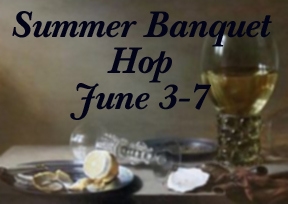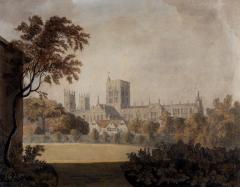
Best known as one of the feared Lady Patronesses of Almack’s, she was born Sarah Sophia Fane in March 3, 1785, the eldest daughter of John Fane, the 10th earl of Westmorland, and his wife Anne Child (or Sarah Anne Child), the only child of the banker, Robert Child. Disapproving of the marriage because Anne eloped at age 17 to Gretna Greene in 1782, with John Fane, her father Robert Child changed his will so that his estate would bypass her and go to either her second son or her eldest daughter. Robert Child died the same year of his daughter’s marriage, so Sarah Sophia was born an heiress. There is no indication of what Sarah Sophia’s relationship with her parents or siblings was. Her mother died when Sarah Sophia was eight.
Sarah Sophia married George Villiers, Viscount Villiers, on May 23, 1804, at home in Berkley Square. However, there were several hints of an elopement to Gretna Green for her. Many of the sources I found were careful not to cite the place of marriage. (This may be a result of confusion with her mother, both being named Sarah. It is also possible that Sarah Sophia and George did elope but also had a ceremony to satisfy family or convention.) By all accounts, she held him in great affection. George became the 5th Earl of Jersey and 8th Viscount Grandison in 1805. Sarah Sophia had inherited the Child fortune and property, including Osterley Park, at birth, and took control when she came of age in 1806. In an age of women as chattels, Sarah was unique in that her inheritance made her the senior partner of Child & Co., a position she held for over 60 years. She took an active interest in the bank, visiting the premises, checking profit and loss statements, and intervening in employee issues. The couple had five sons and three daughters, seven of whom survived to adulthood.
Sarah Sophia, also known as Sally, became a leader of the “Ton”, and wielded a great deal of influence in Society. Sarah Sophia was considered a great beauty. She made a name for herself by being extremely rude and behaving theatrically. She chattered incessantly, acquiring the nickname of “Silence.” Determined to stand apart from her mother-in-law, the scandalous Frances, Lady Jersey, who was mistress of the Prince of Wales, Sarah Sophia made a great show of personal virtue, although she apparently throve on gossip. In spite of her affectations, she appears to have been regarded with affection by many of her peers. In a letter written in 1816 to her brother, General Alexander Beckendorf, Princess Lieven described Lady Jersey as one of her “most intimate friends.” (Princess Lieven also said in a later letter to Prince Metternich that “…Lady Jersey has the most dangerous tongue I know.” Written in 1823, it would appear that there had been a falling out.) Although she called herself Sally, one of her nicknames in Society was “Queen Sarah.” When Lady Caroline Lamb published her novel GLENARVON in 1816, Lady Jersey was supposedly the inspiration for the character of Lady Augusta. As a result, “Queen Sarah” banned Caroline from Almack’s, effectively ending Caroline’s social career.
Sarah Sophia and her husband entertained at their home in Berkley Square, and Middleton Park in Oxfordshire. They seem to have spent little time at Osterley Park in Middlesex. Sarah Sophia is supposed to have introduced the Quadrille to Almack’s in 1815. She was a noted political hostess for her husband, who legally added the name of Child in 1819 to become George Child-Villiers, Earl of Jersey. An avid hunter and racing aficionado, her husband held offices in the households of William IV and of Queen Victoria. Sarah Sophia was interested in politics, and not shy about expressing her opinions. She apparently switched from Whig to Tory views by the 1820’s. She supported Queen Caroline against George IV when he tried to divorce Caroline, wearing a portrait of Caroline in public. Sarah Sophia also spoke openly against the Reform Bill of 1832.
George died October 3, 1859, followed shortly by their eldest son. Her grandson (her oldest son’s son) inherited the title. After her husband’s death, she continued to entertain and take an interest in what was going on around her, especially charitable concerns including the establishment of schools on the family estates to assist tenants and laborers. She died of a ruptured blood vessel, according to her obituary, at Berkley Square on January 26, 1867, at age 81, outliving her husband and six of her seven children. Both Lord and Lady Jersey were buried at Middleton Stoney, Oxfordshire.
Lady Jersey’s fame lived on after her, and she appears in Regency romance novels by many authors, including Georgette Heyer, frequently as a character. She will also be seen in my upcoming novel, due out later this year.
[This is an expansion of some information I posted on Goodreads on Oct. 20, 2011 in the Historical Info for Historical Fiction Readers group.]
Gronow, Captain Rees Howell. Reminiscences of Captain Gronow. Originally published 1862: Smith, Elder & Co., London; republished by IndyPublish.com, McLean, VA.
Quennell, Peter, ed. The Private Letters of Princess Lieven to Prince Metternich 1820-1826. 1938: E. P. Dutton & Co. Inc. NY. (P. 283)
Robinson, Lionel G. Letters of Dorothea, Princess Lieven, during her Residence in London, 1812-1834. 1902: Longmans, Green, and Co. London. (P. 29)
“Child & Co, Bankers of London.” http://www.hypatia.demon.co.uk/ost2006/historical_bank.html
Find A Grave. “Sarah Sophia Fane Child-Villiers.” http://www.findagrave.com/cgi-bin/fg.cgi?page=gr&GRid=91951396
“Osterley Park– A Brief History.” http://www.hypatia.demon.co.uk/ost2006/historical_brief.html
One London One blog. “The Death of Lady Jersey in 1867.” By Kristine Hughes and Victoria Hinshaw. Posted March 3, 2012. http://onelondonone.blogspot.com/2012/03/death-of-lady-jersey-in-1867.html
The Peerage Online. “Lady Sarah Sophia Fane.” http://www.thepeerage.com/p2703.htm
RBS Heritage Online. “Sarah Sophia Child-Villiers.” http://heritagearchives.rbs.com/wiki/Sarah_Sophia_Child-Villiers
Regency History. “Lady Jersey (1785-1867).” By Rachel Knowles, posted Nov. 4, 2011. http://www.regencyhistory.net/2011/11/lady-jersey-1785-1867.html
A Web of English History. “Sarah Sophia Child, Lady Jersey, 1785-1867.” Dr. Marjory Bloy. http://www.historyhome.co.uk/people/jersey.htm
Image: from Wikimedia Commons- Sarah Sophia Child Villiers, Countess of Jersey (née Fane) (1785-1867) by Alfred Edward Chalon, painted in the first half of the 19th century. http://upload.wikimedia.org/wikipedia/commons/thumb/d/dc/Sarah_Sophia_Child_Villiers%2C_Countess_of_Jersey_%28n%C3%A9e_Fane%29_%281785-1867%29%2C_by_Alfred_Edward_Chalon.jpg/361px-Sarah_Sophia_Child_Villiers%2C_Countess_of_Jersey_%28n%C3%A9e_Fane%29_%281785-1867%29%2C_by_Alfred_Edward_Chalon.jpg







